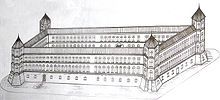Freudenthal Castle

Freudenthal Castle is a castle complex built in the 16th century in the small town of Uslar in southern Lower Saxony . Mainly because of its size, it is considered one of the most important palace complexes in northwest Germany. The facility, built in the style of the Weser Renaissance , also known as the “Pearl of the Weser Renaissance”, burned down 53 years after construction began after a lightning strike and was not rebuilt. From the castle ruins in today's Uslarer Schlosspark, southwest of the old town, walls of the basement are still present.
Building description
The palace, completed in 1565, was a four-wing complex with an almost square inner courtyard. With side lengths of 85 × 95 m, the castle was enormous. The castle wings had long rows of windows. Each of the four corners of the building had a projecting castle tower. The entire structure was built on two floors on a base and was based on a stone foundation several meters deep in the boggy ground. The stone material used is hewn red sandstone blocks from the Bückeberg mountains near Obernkirchen . This sandstone was the most expensive building material at the time. The interiors used to be artistically painted by Dutch artists. The extensive construction plans for the magnificent palace were only partially implemented.
After the fire of 1612, the castle was no longer built. The walls of the basement level are still in place in the palace park southwest of the city center. The palace was replaced by the princely administrative building, which from 1855 was the district office of the former Uslar district . A Merian engraving by Uslar from 1654, around 40 years after the fire, shows the castle ruins with their moat.
history
The name of the castle is based on the Freudenthal valley in which Uslar is located. The building was built between 1559 and 1565. The builder was Duke Erich II of Braunschweig-Lüneburg . He served Emperor Charles V , who was King of Spain and the Netherlands . Since Erich was a mercenary leader in the Netherlands for a long time , he hired builders from there to build the castle. In order to have a better view from the castle and to get a larger forecourt, the residents of Uslar were relocated in 1561. This relocation resulted in the “Neustadt” in front of the east gate, which explains the name of today's Neustädter Platz.
In 1575, during a campaign from the army camp near Nancy , Erich II issued the decree that Uslar would be renamed after the castle in Freudenthal. But the city did not comply. The Duke undertook a similar renaming in 1574 with Neustadt am Rübenberge , which he named Landestrost after the castle he had built there. Otherwise the citizens of Uslar were not very enthusiastic about the construction of the ducal palace. For the major project, they had to do free manual and clamping services to their sovereign . The castle never served as a princely residence for its builder. Erich II used it as a pleasure and hunting palace . During his rare stays in Uslar it was the starting point for hunting activities in the Solling . For the most part, however, he stayed on his Dutch possessions or took part in military campaigns abroad as a mercenary leader on behalf of others.
Together with the Guelph castles of Erich II in Hann. Münden and Landestrost Castle in Neustadt am Rübenberge count Freudenthal Castle among the important buildings that the Duke had built during his reign. He financed his building projects in part through his quite successful military campaigns, during which he stole large sums of money or was rewarded with property abroad. It was customary for mercenary leaders to invest war profits in construction projects in this way.
today
Archaeological investigations were carried out on the castle ruins in 1979 and 1980. Then the remains were converted into a park and garden ("Castle Park"). The historic complex has been used for cultural events by private initiative since around 2010. For example, the "Art Market Uslar" took place there in 2012, 2013, 2015 and 2017. The "Schlosspark" is also very popular with young people to have a barbecue there.
literature
- Ernst Andreas Friedrich : The castle ruins Freudenthal in Uslar. In: If stones could talk. Volume IV, Landbuch-Verlag, Hanover 1998, ISBN 3-7842-0558-5 , pp. 180-181.
Individual evidence
- ↑ Schloss Freudenthal article in the Regio-Wiki of the HNA ( Hessische / Niedersächsische Allgemeine )
- ↑ The Pearl of the Weser Renaissance Entry on the website of the city of Uslar
- ↑ 4th Art Market in the Freudenthal Palace Park Info on the City of Uslar website
Web links
- Entry by Gudrun Pischke zu Uslar in the scientific database " EBIDAT " of the European Castle Institute
Coordinates: 51 ° 39 ′ 30 ″ N , 9 ° 37 ′ 53 ″ E



